Submitted:
06 June 2023
Posted:
06 June 2023
You are already at the latest version
Abstract
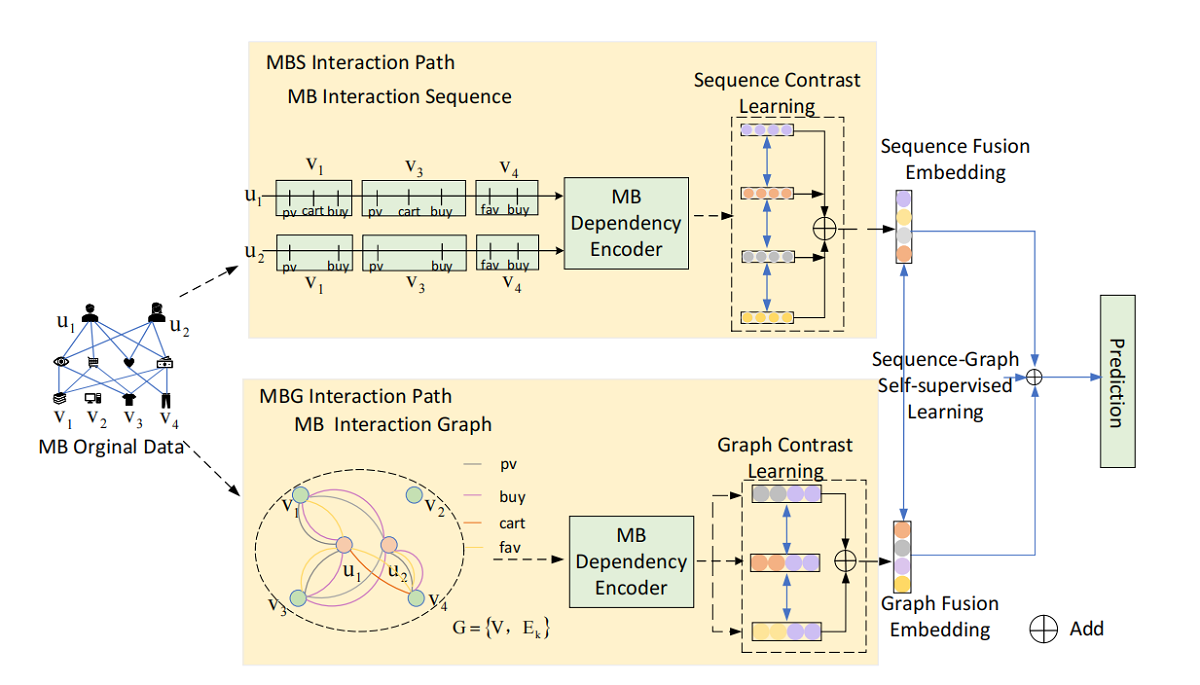
Keywords:
0. Introduction
- In order to distinguish the ability of different users’ behavioral perception preferences, we propose a new Multi-Behavioral attention Two-path Self-Supervised learning framework. The strategy of Multi-Behavior interaction sequence path and Multi-Behavior interaction graph path based on attention is proposed. It emphasizes the necessity of modeling the dependency relationship between different behaviors of users.
- In order to capture the commonality of multiple behaviors of users, we design three contrastive learning methods. It not only enhances the representation results of two paths, but also enables the model to obtain more auxiliary supervision signals in the Self-Supervised learning within paths and between paths. It effectively alleviates the problem of sparse supervisory signals.
- We conduct extensive experiments on two real world user behavior datasets. Experiments show that the recommendation performance of TP_MB outperforms many current popular baseline models.
1. Related Work
1.1. Self-Supervised Representation Learning
1.2. Ggeneral Recommendation
1.3. Multi-Behavior Recommendation System
2. Materials and Methods
2.1. Problem Formulation
2.2. Multi-Behavior Interactive Sequence Path
2.2.1. Multi-Behavior Interaction Sequence Embedding(MBS Embedding)
2.2.2. Multi-Behavior Interaction Sequence Attention Representation(Attention Fusion)
2.2.3. Multi-Behavior Interaction Sequence Modeling
2.2.4. Multi-Behavior Interaction Sequence Contrast Loss(Sequence Contrast Learning)
2.3. Multi-Behavior Interaction Graph Path
2.3.1. Multi-Behavior Interaction Graph Embedding
2.3.2. Attention Representation of Multi-Behavior Interaction Graph in Two-path(Graph-inner Attention)
2.3.3. Multi-Behavior Interaction Graph Contrast Loss(Graph Contrast Learning)
2.4. Contrast Loss for Two-Path Enhancement
3. Results
- RQ1: Whether TP_MB can achieve better performance compared to the State-Of-The-Art model?
- RQ2: In our designed TP_MB, analyze the influence of each component on each other.
- RQ3: How different hyperparameters affect model performance?
3.1. Experimental Results and Analysis
3.2. Datasets
3.3. Implementation Details and Environment
3.4. Baseline
- LightGCN [9]:A simplified method of traditional GCN. This model removed the feature transformation and Non-Linear activation operations of the aggregation layer and propagation layer in the standard GCN, and only consisted of neighborhood aggregation, making it more concise and more suitable for recommendation systems.
- BERT4Rec [7]: To Modeled user behavior through Self-Attention mechanism, and fused project neighbor information for recommendation.
- Caser [9]:For the most recent project, graph convolution was embedded in time and space to model the dynamic change of user interest over time.
- GHCF [2]:The model encoded the behavior of users interacting with products, and the behavior pattern was embedded into the overall heterogeneous graph as a node when composing the graph. At the same time, LightGCN was used to realize aggregation and propagation between nodes.
- DHSL-GM [10]:Similar users and similar items constituted hypergraphs respectively. The gated neural network was used to predict less popular items in a more balanced manner. It was the latest use of Self-Supervised learning to model the representation of users and products on the dual hypergraph. This model was a relatively advanced method at present, and was also the main comparison object of this paper.
3.5. Performance Comparison
3.6. Ablation Study
- Remove path attention -Att: Different modal relationships between multiple behaviors are not captured using attention in the two paths.
- Remove two-path Self-Supervision -DCL: No two-path contrastive learning strategy is used to supplement sparse data.
3.7. Hyper-Parameters Analysis
4. Conclusion
Funding
Author Contributions: Mingyue Qu
Institutional Review Board Statement
Informed Consent Statement
Data Availability Statement
Acknowledgments
Conflicts of Interest
Sample Availability
Abbreviations
| TP_MB | Two-path Multi-behavior Sequence Modeling |
References
- Wang J, Huang P, Zhao H, et al. Billion-scale Commodity Embedding for E-commerce Recommendation in Alibaba[J]. ACM, 2018. [CrossRef]
- Chen, Chong, et al. "Graph heterogeneous multi-relational recommendation." Proceedings of the AAAI Conference on Artificial Intelligence. Vol. 35. No. 5. 2021. [CrossRef]
- Velikovi P, Fedus W, Hamilton W L, et al. Deep Graph Infomax[J]. 2018. [CrossRef]
- Wu J, Wang X, Feng F, et al. Self-supervised Graph Learning for Recommendation[J]. ACM, 2021. [CrossRef]
- Jin B, Gao C, He X, et al. Multi-behavior Recommendation with Graph Convolutional Networks[C]// SIGIR ’20: The 43rd International ACM SIGIR conference on research and development in Information Retrieval. ACM, 2020. [CrossRef]
- Wang W, Zhang W, Liu S, et al. Beyond Clicks: Modeling Multi-Relational Item Graph for Session-Based Target Behavior Prediction[J]. 2020. [CrossRef]
- Sun F, Liu J, Wu J, et al. BERT4Rec: Sequential Recommendation with Bidirectional Encoder Representations from Transformer[J]. 2019. [CrossRef]
- Velikovi P, Cucurull G, Casanova A, et al. Graph Attention Networks[J]. 2017.
- He X, Deng K, Wang X, et al. LightGCN: Simplifying and Powering Graph Convolution Network for Recommendation[J]. ACM, 2020. [CrossRef]
- Gao, Rong, et al. "Gated Dual Hypergraph Convolutional Networks for Recommendation with Self-supervised Learning." 2022 International Joint Conference on Neural Networks (IJCNN). IEEE, 2022. [CrossRef]
- Hjelm R D, Fedorov A, Lavoie-Marchildon S, et al. Learning deep representations by mutual information estimation and maximization[J]. 2018. [CrossRef]
- Bachman P, Hjelm R D, Buchwalter W. Learning Representations by Maximizing Mutual Information Across Views[J]. 2019.
- Chen C, Zhang M, Zhang Y, et al. Efficient Heterogeneous Collaborative Filtering without Negative Sampling for Recommendation[J]. Proceedings of the AAAI Conference on Artificial Intelligence, 2020, 34(1):19-26. [CrossRef]
- Koren Y, Rendle S, Bell R. Advances in collaborative filtering[J]. Recommender systems handbook, 2021: 91-142. [CrossRef]
- Huang C, Wu X, Zhang X, et al. Online purchase prediction via multi-scale modeling of behavior dynamics[C]//Proceedings of the 25th ACM SIGKDD international conference on knowledge discovery & data mining. 2019: 2613-2622. [CrossRef]
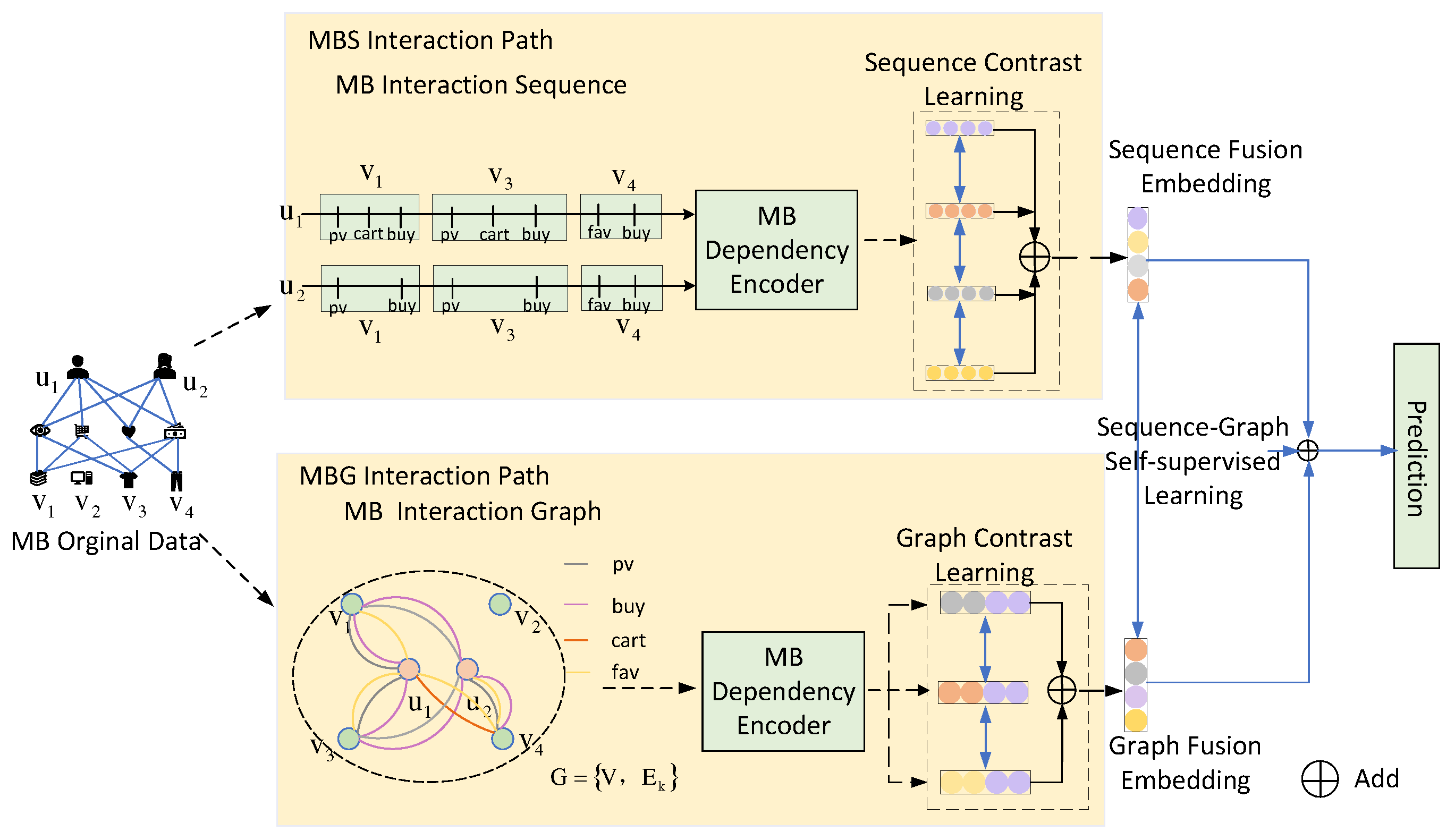
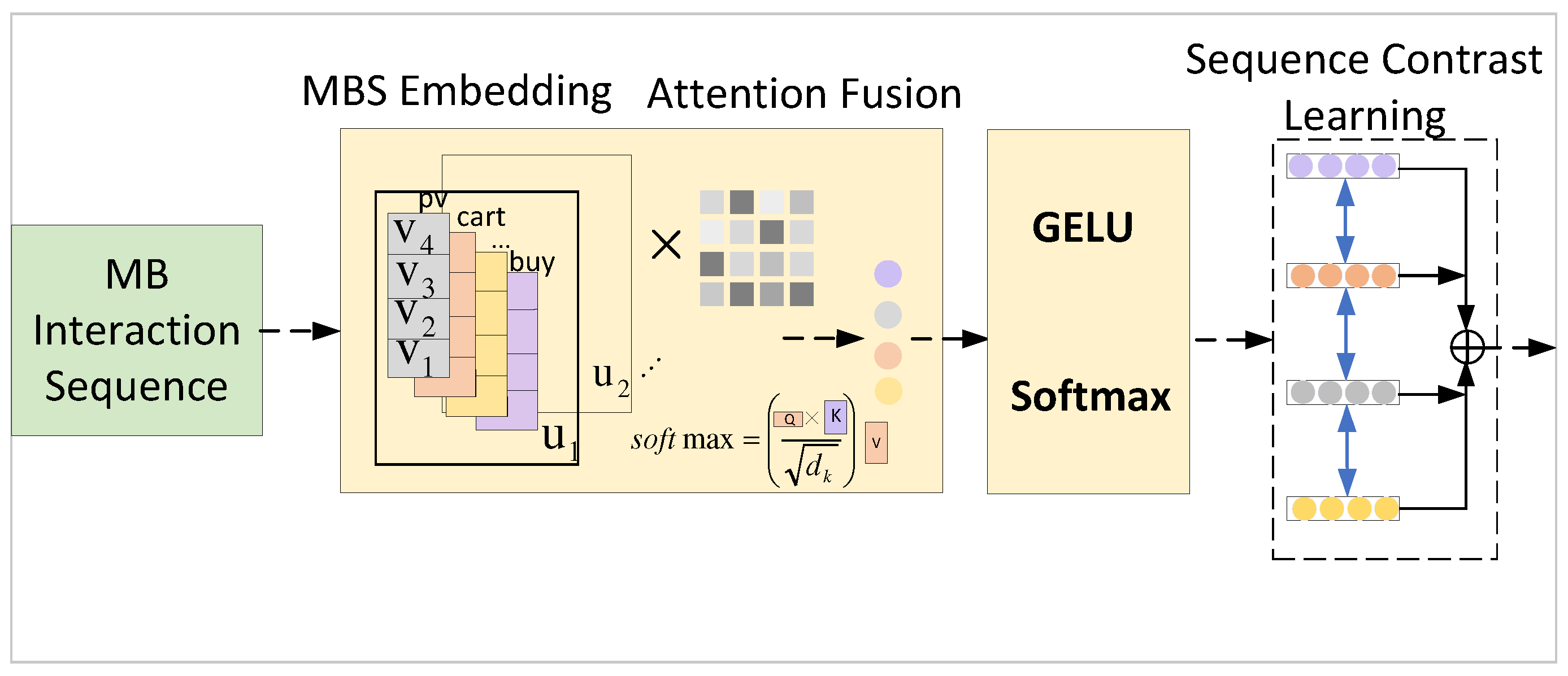
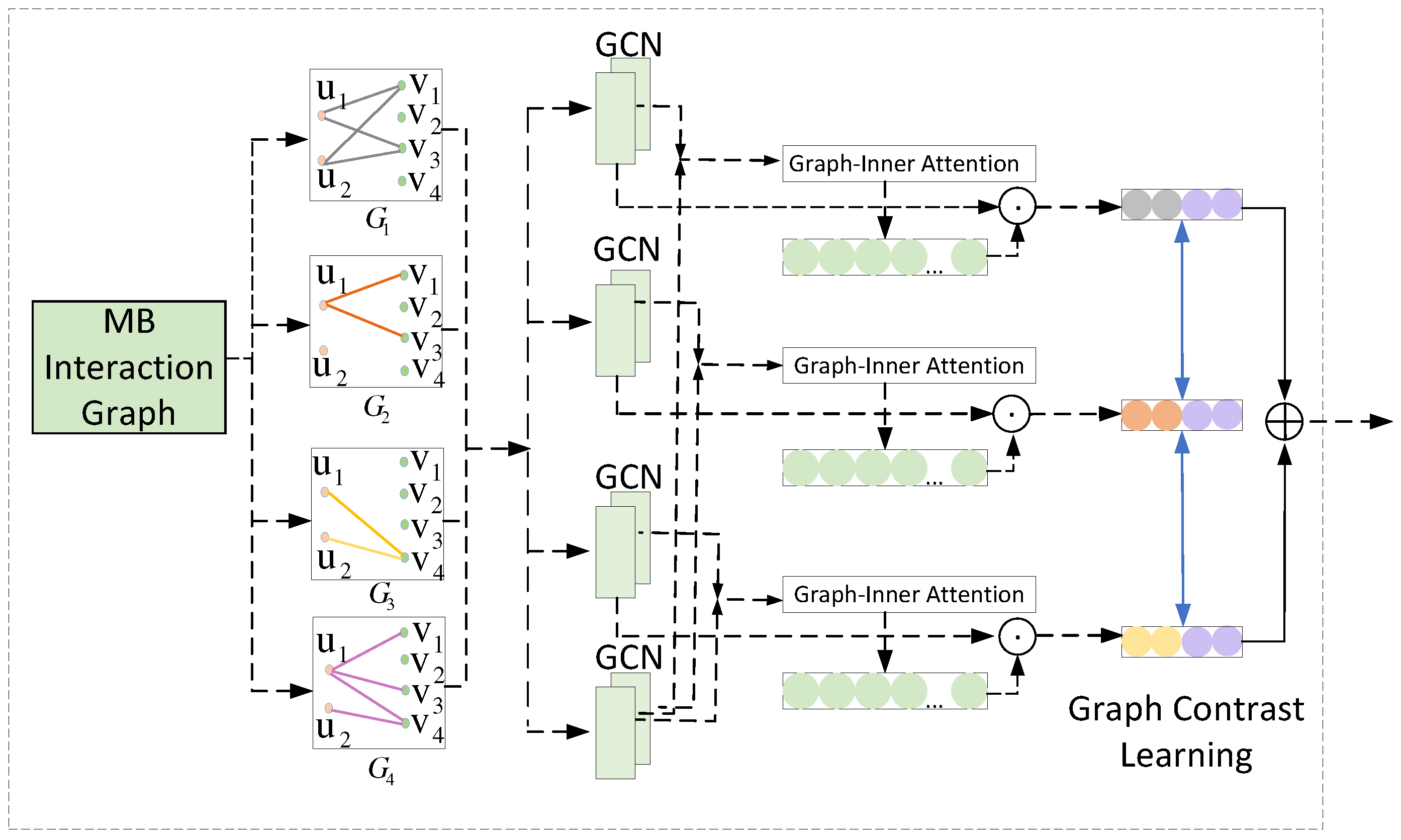
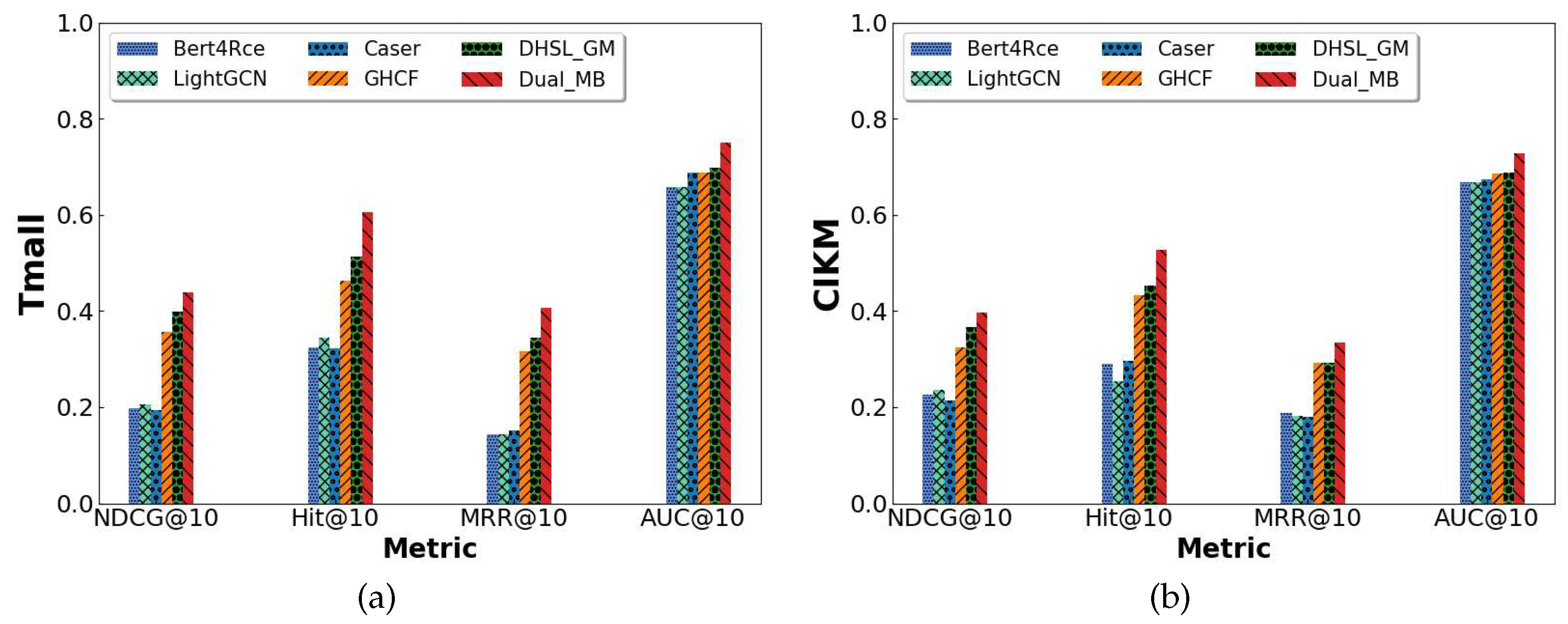
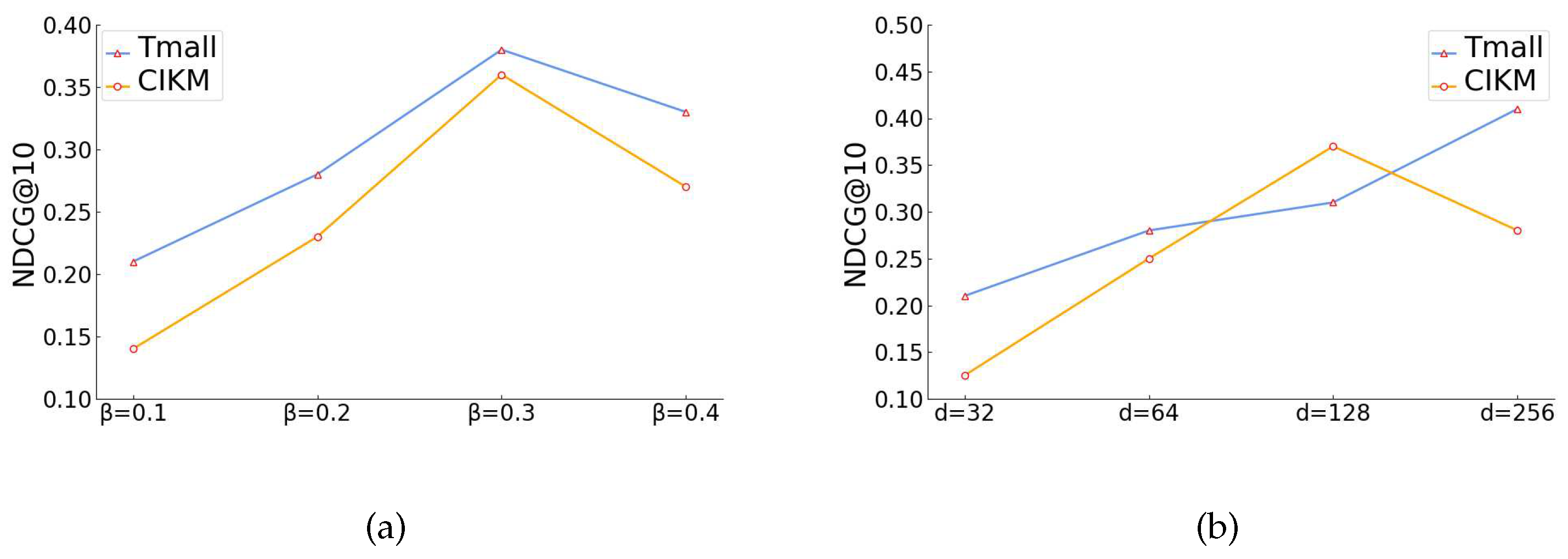
| Dataset | User | Item | Interaction | Interaction Behavior Types |
|---|---|---|---|---|
| Tmall | 27155 | 22014 | 613978 | {click,add_to_cart,buy} |
| CIKM2019EComm AI | 23023 | 25054 | 41526 | {click,add_to_cart,buy} |
| Data | Metric | Bert4Rec | LightGCN | Caser | GHCF | DHSL_GM | TP_MB | Improvement |
|---|---|---|---|---|---|---|---|---|
| Tmall | NDCG@10 | 0.1985 | 0.2051 | 0.1933 | 0.3754 | 0.3983 | 0.4393 | 10.3% |
| Hit@10 | 0.3274 | 0.3447 | 0.3231 | 0.4635 | 0.5126 | 0.6053 | 18.1% | |
| MRR@10 | 0.1447 | 0.1447 | 0.1522 | 0.3164 | 0.3437 | 0.4066 | 8.2% | |
| AUC@10 | 0.6583 | 0.6583 | 0.6876 | 0.6873 | 0.6981 | 0.7505 | 7.5% | |
| CIKM | NDCG@10 | 0.2264 | 0.2352 | 0.2139 | 0.3244 | 0.3662 | 0.3970 | 8.4% |
| HiT@10 | 0.2896 | 0.2534 | 0.2962 | 0.4337 | 0.4537 | 0.5277 | 16.3% | |
| MRR@10 | 0.1878 | 0.1811 | 0.1790 | 0.2926 | 0.3108 | 0.3344 | 7.6% | |
| AUC@10 | 0.6686 | 0.6671 | 0.6731 | 0.6866 | 0.6874 | 0.7273 | 5.8% |
| Data | Tmall | CIKM | ||
|---|---|---|---|---|
| Metric | Hit@10 | NDCG@10 | Hit@10 | NDCG@10 |
| w/o-Att | 0.3431 | 0.1863 | 0.2581 | 0.1264 |
| w/o-DCL | 0.3108 | 0.1773 | 0.3630 | 0.1973 |
| MB_gsCL | 0.6053 | 0.4393 | 0.5277 | 0.3970 |
Disclaimer/Publisher’s Note: The statements, opinions and data contained in all publications are solely those of the individual author(s) and contributor(s) and not of MDPI and/or the editor(s). MDPI and/or the editor(s) disclaim responsibility for any injury to people or property resulting from any ideas, methods, instructions or products referred to in the content. |
© 2023 by the authors. Licensee MDPI, Basel, Switzerland. This article is an open access article distributed under the terms and conditions of the Creative Commons Attribution (CC BY) license (https://creativecommons.org/licenses/by/4.0/).




